New Mexico is nicknamed ‘Land of Enchantment’ thanks to its beautiful and varied scenery. From white sandy beaches to thick, lush forests, this US state has a varied landscape and there are some stunning New Mexico landmarks to see. The land is divided into three main regions: the Great Plains, the Rocky Mountains and the Basin and Range. Native to New Mexico are black bears, cougars and the rare black-footed ferret.
In 1912, New Mexico became the 47th state to join the Union of the United States of America. People have been in New Mexico for over 12,000 years, reaching the area during the last ice age by crossing a land bridge now covered by water. Four Native American tribes lived in the area for thousands of years, each making their mark on the landscape. The Apache, Zuni, Navajo and Pueblos peoples built incredible structures, painted petroglyphs and transformed a once harsh landscape into somewhere to live and farm.
The first Spanish explorer to arrive was Francisco Vazques Coronado in 1540, who came to find cities built entirely from gold. Following Coronado’s expedition, more Spaniards came to New Mexico and soon colonised the area. The area remained under Spanish rule until 1821, when Mexico declared independence from Spain. After that, it enjoyed a brief period as part of Mexico, before the United States won the Mexican-American war of 1848, and the land became US territory.
Whether it is learning about New Mexico’s rich history or exploring its vast and beautiful landscapes, there is something for everyone to enjoy. So here are 20 famous landmarks in New Mexico to get you started.
21 New Mexico Landmarks
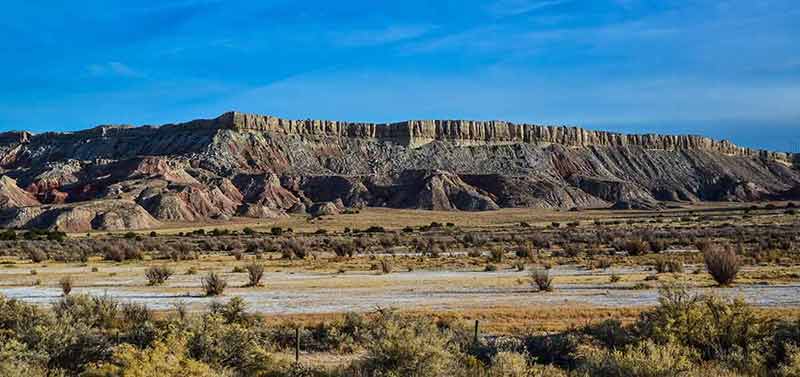
Natural Landmarks in New Mexico
1- Cerro Grande
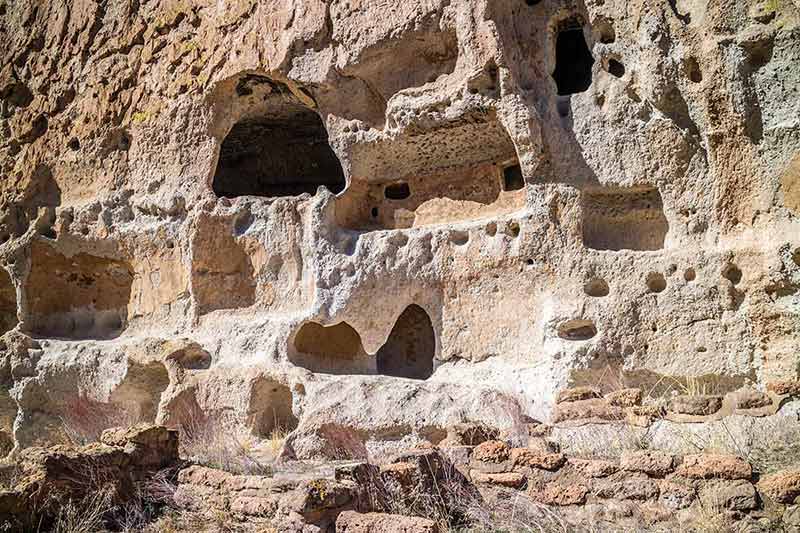
Cerro Grande, which is 3109 meters (10,199 feet), is the highest point in Bandelier National Monument.
The National monument covers a vast 33,677 acres (13,600ha) of New Mexico and preserves the land belonging to the Ancestral Puebloans who lived here between 1150 and 1600AD.
Much of the monument is wilderness, which stretches along the Rio Grande at varying heights.
When visiting Bandelier National Monument, be sure to explore the ancient Pueblo sites scattered across the land.
Important sites include Tyuonyi pueblo, a circular area that was once three stories tall.
Next to Tyuonyi is a longhouse built into the walls of the canyon.
Bandelier National Monument is at 15 Entrance Rd, Los Alamos, NM 87544.
2- Carlsbad Cavern

When visiting Carlsbad Caverns National Park, be sure to head into the show cave, Carlsbad Cavern.
Jim White, a teenager in 1898, was the first person to explore the caverns, where he climbed down using a homemade wire ladder.
White named many areas of the caverns, including the New Mexico Room, Green Lake Room and some unique features, such as the Totem Pole and Iceberg Rock.
More recent explorations in 1993 led to the discovery of more areas of the caverns.
A series of small passages totalling approximately 1 mile (1.6 kilometres) was named Chocolate High.
Another discovery was the Bottomless Pit because early explorers believed the pit had no bottom as when they dropped stones, no sound was heard to indicate a bottom.
Later discoveries found that the Bottomless Pit was 140ft (43m) underground and covered in soft dirt that cushioned the dropped stones.
Carlsbad Caverns is at Carlsbad, NM 88220.
3- Wheeler Peak
Wheeler Peak is New Mexico’s highest peak at 13,167ft (4013m).
Once known as Taos Peak, due to its proximity to the town of Taos, it was renamed in 1950 by Major George Montague Wheeler. He led surveyors and naturalists across New Mexico collecting data about the natural landscape during the mid to late 1800s.
Many hiking routes surround the peak through the wilderness and lead up to the mountain itself.
The most popular hike is a trek along the north ridge, crossing the neighbouring peak of Mount Walter before reaching Wheeler.
Wheeler Peak is at Taos Ski Valley, NM 87525.
4- Bisti /De-Na-Zin Wilderness
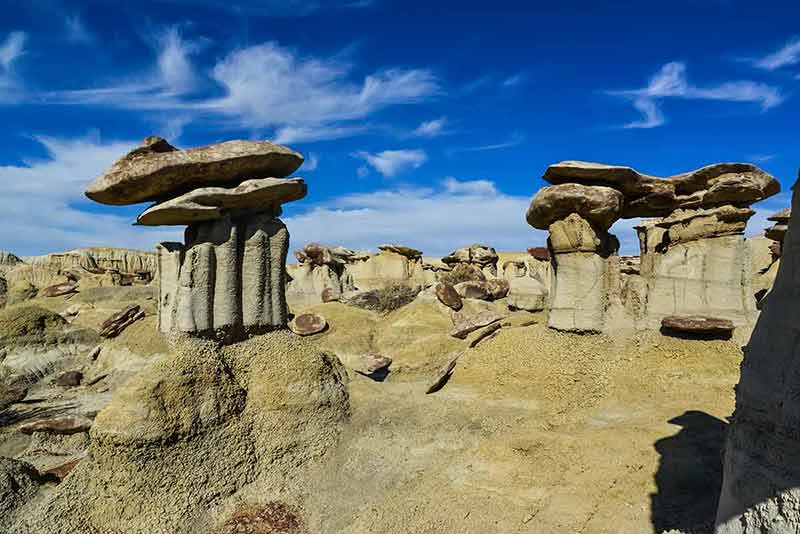
Bisti/De-Na-Zin Wilderness is a rolling badlands landscape in the Four Corners region of New Mexico.
The landscape is an ocean of unusual rock formations created by weathering across the centuries.
The sandstone was weathered into pinnacles and spires, creating an almost alien landscape.
The name combination for the wilderness comes from the Navajo. Bisti means ‘large area of shale hills’, and De-Na-Zin means’ cranes’.
The landscape is adjacent to tribal lands, and besides its impressive geological features, you can also find samples of petrified wood.
Bisti Wilderness is at Country Road 7297, Bloomfield, NM 87413.
5- Capulin Volcano
Capulin Volcano is a young volcano dating from between 55,000 and 62,000 years old.
The volcano has a cylindrical cone and a crater that is 400ft (121m) deep.
You can trek to the top of the volcano for incredible views across the valleys surrounding it, towards snow-capped mountains and parts of the four states that border New Mexico: Oklahoma, Kansas, Texas and Colorado.
The area surrounding Capulin Volcano is an International Dark-Sky Association Gold Tier-certified area popular with star gazers as there is no light pollution.
On clear nights, the Milky Way is incredibly bright in the sky above.
Capulin Volcano is at 46 Volcano, Capulin, NM 88414.
For more about New Mexico, also read:
6- Kasha-Kutuwe Tent Rocks
Kasha-Kutuwe Tent Rocks is a unique rock formation to the southwest of Santa Fe.
In the Pueblo Keresan language, ‘Kasha-Kutuwe’ means ‘white cliffs’, named for the colour of the rocks.
The rock formations consist of volcanic rock and ash that spewed from a volcanic eruption in the Jemez Mountains between 6 and 7 million years ago.
Due to millennia of erosion, the rocks gradually formed slot canyons and tent rocks. The highest tent rock is 90ft (27m).
To see most of the rock formations, trek along the Slot Canyon trail.
The trail is a one-way trail leading hikers 1.5 miles (2.4 kilometres) through the canyon and up to a rock 630ft (190m) with incredible views over the rocks.
Tent Rocks is at 0 NM-22, Cochiti Pueblo, NM 97072.
7- Shiprock
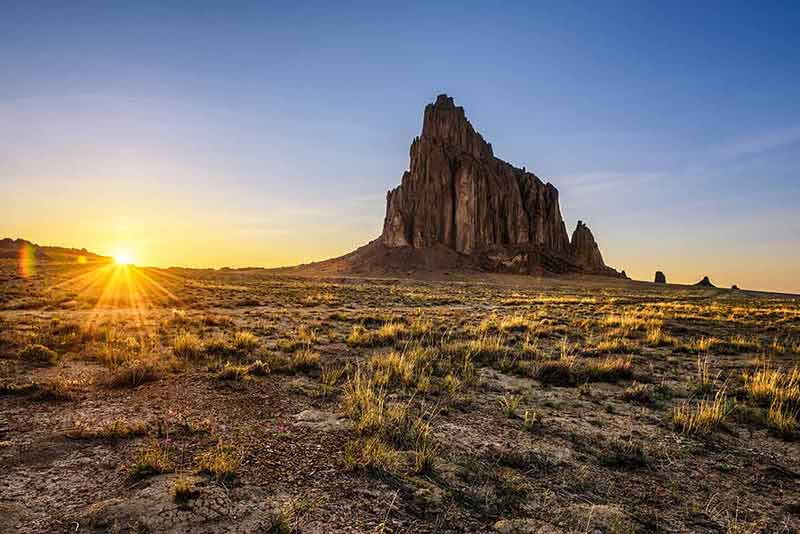
Shiprock gets its name from the Navajo and means ‘rock with wings’.
The rock formation is a monadnock 1583ft (482.5m) above sea level and is protected by the Navajo Nation, as the rock is a significant landmark of the Navajo.
The Shiprock area was also once populated by the Ancient Pueblo People.
Shiprock is a popular location for rock climbers seeking a challenge and for photographers.
The rock has even been featured in novels and movies, including Jumanji, The Host and The Lone Ranger.
Ship Rock is at Shiprock, San Juan County, NM.
8- Rio Grande Gorge
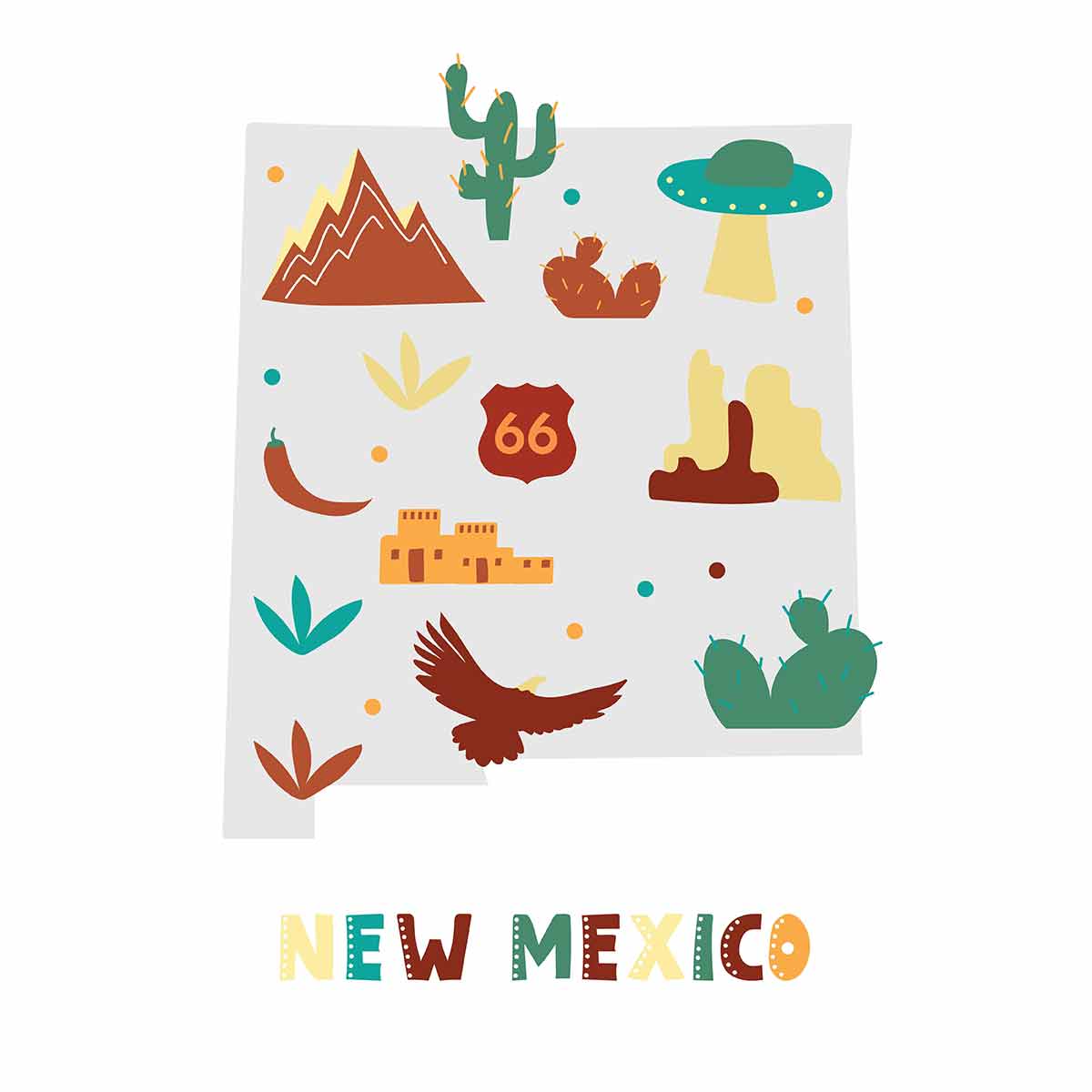
The Rio Grande Gorge is a breathtaking natural landmark in New Mexico.
The Rio Grande follows a tectonic chasm across the state and the deepest point in the gorge is 800ft (240m).
Erosion over millions of years, volcanic activity, the movement of tectonic plates carved the gorge out of the rocks.
Within the gorge lies a unique ecosystem of juniper forests with 500-year-old trees, bighorn sheep and red-tailed hawks.
Rio Grande Gorge stretches from the Colorado border for 50 miles (80km) towards the southeast corner of Taos.
9- Blue Hole
The Blue Hole is part of a collection of seven lakes connected through an underground water system.
The Blue Hole is a creation of nature; it’s a natural artesian well and a collapsed cavern created by limestone bedrock dissolving naturally.
It’s filled with clear blue water that gradually gets darker and darker as it reaches the hole’s depths.
Many scuba divers head to the Blue Hole due to the 100′ visibility offered.
This incredible level of visibility is due to the waters renewing themselves every six hours, meaning the lake is never truly the same twice.
The waters are a pleasant 62 degrees, making it a popular spot for swimming during the warm summer months.
Blue Hole is at 1085 Blue Hole Road, Santa Rosa, NM 88435.
10- White Sands National Park
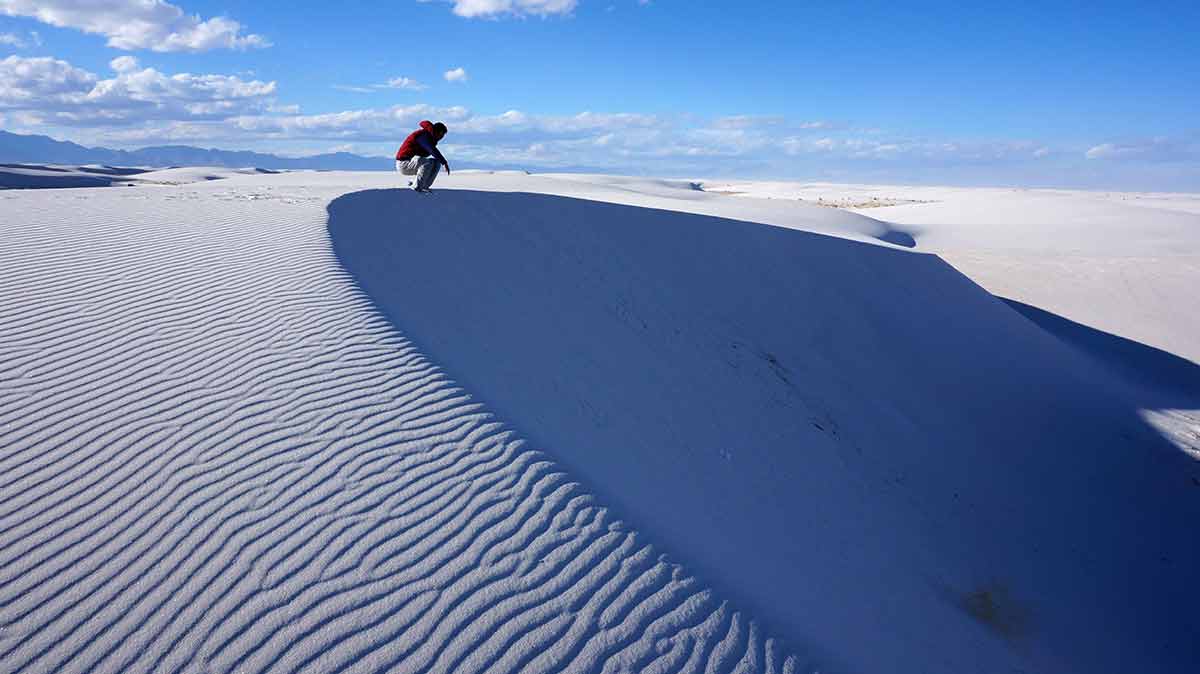
White Sands National Park is an unusual landscape in New Mexico where Star Wars was filmed in 1974.
The White Sands Missile Range, a missile testing range where the US Army tested the first atomic bomb, surrounds White Sands National Park.
White Sands covers 145,762 acres (59,000 ha) of dunes made from gypsum crystals and are the largest and some of the most impressive in the USA.
The largest dune is 60ft (18m), with a landscape consisting of more than 4.5 billion tonnes of gypsum.
Despite its unusual makeup, the landscape is filled with thousands of species, including the Apache pocket mouse and the bleached earless lizard.
White Sands National Park is at 19955 US-70, Alamogordo, NM 88310.
Also read:
- 20 USA Landmarks
- 23 Canada Landmarks
- 22 Ohio Landmarks
- 21 Arizona Landmarks
- 21 Minnesota Landmarks
- 21 Oregon Landmarks
- 21 Illinois Landmarks
- 21 Colorado Landmarks
- 21 Georgia Landmarks
- 21 Michigan Landmarks
- 23 Los Angeles Landmarks
- 21 Washington Landmarks
- 21 Maryland Landmarks
- 20 Manitoba Landmarks
- 20 Kansas Landmarks
- 21 New Mexico Landmarks
- 20 Idaho Landmarks
- 20 Montana Landmarks
- 20 Oklahoma Landmarks
- 21 Wisconsin Landmarks
- 20 Tennessee Landmarks
- 21 Iowa Landmarks
- 20 Alaska Landmarks
- 20 Miami Landmarks
- 21 West Virginia Landmarks
- 21 Kentucky Landmarks
- 20 Louisiana Landmarks
- 21 Arkansas Landmarks
- 20 Cincinnati Landmarks
- 20 San Antonio Landmarks
- 25 Indiana Landmarks
- 21 New York Landmarks
- 20 Texas Landmarks
- 21 Boston Landmarks
- 20 Florida Landmarks
- 20 Hawaii Landmarks
- 5 South Dakota Landmarks
- 21 Pennsylvania Landmarks
- 23 New Jersey Landmarks
- 21 Virginia Landmarks
- 21 North Carolina Landmarks
- 21 Utah Landmarks
- 21 Nevada Landmarks
- 20 Massachusetts Landmarks
- 20 Washington DC Landmarks
- 20 Vermont Landmarks
- 20 Nebraska Landmarks
- 20 North Dakota Landmarks
- 21 Missouri Landmarks
- 20 Rhode Island Landmarks
- 21 Maine Landmarks
- 21 Connecticut Landmarks
- 20 San Diego Landmarks
- 20 Landmarks In South Carolina
- 20 Mississippi Landmarks
- 20 Las Vegas Landmarks
- 20 Dallas Landmarks
- 20 Houston Landmarks
- 20 Seattle Landmarks
Historic Landmarks in New Mexico

11- Boca Negra Canyon
Boca Negra Canyon is one of three canyons in the Petroglyph National Monument, where incredible petroglyphs can be seen.
A short hike along Boca Negra canyon offers 100 petroglyphs, while a hike of 1.5 miles (2.4 kilometres) in the Piedras Marcadas Canyon will take in 400.
Petroglyph National Monument is one of the most extensive petroglyph sites in North America.
It showcases designs in the rocks carved between 400 and 700 years ago by Native Americans and Spanish settlers.
The national monument area covers 17 miles (27 kilometres) and is bordered to the west by a chain of dormant fissure volcanoes.
Petroglyph National Monument is at Western Trail NW, Albuquerque, NM 87120.
12- Palace of the Governors
Nestled within the Santa Fe Historic District is the Palace of the Governors, built by Pedro de Peralta in 1610 when he became governor of the Spanish territory.
The palace changed hands as ownership of the land changed and was modified over time to meet a growing range of needs.
The palace was earmarked to be the home of the New Mexico Museum in 1909 and renovated in a Spanish-Pueblo style to maintain its ties to earlier cultures.
Palace of the Governors is at 105 W Palace Ave, Santa Fe, NM 87501.
13- Taos Pueblo
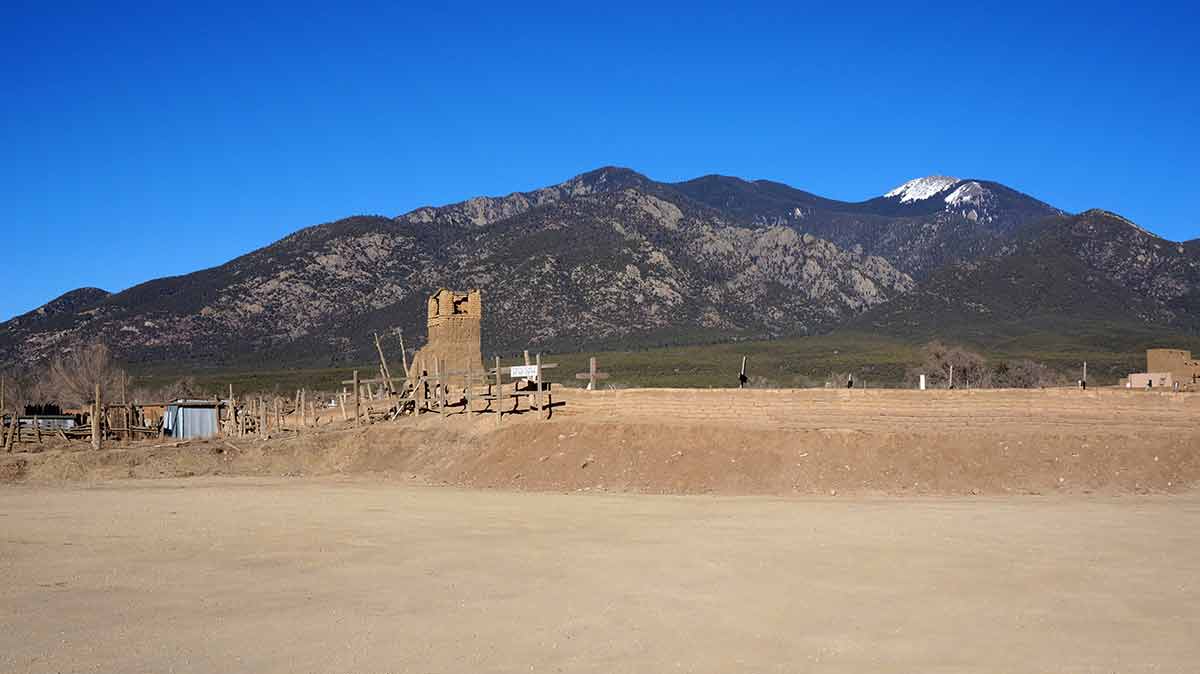
Taos Pueblo is a living Native American community that has been continuously inhabited for more than 1000 years.
The pueblo and its people are unique.
The tribe of Puebloan peoples rarely speak to outsiders of their religious customs and have never written their language down.
As such, they rely on stories passed down through generations to keep the language alive.
As a result, many of their traditions and customs remain a mystery to the rest of the world.
The buildings in the pueblo are made from reddish-brown adobe and are believed to have been first built between 1000 and 1450.
Taos Pueblo is both a UNESCO World Heritage Site and a National Historic Landmark and is the only living Native American community awarded both.
Taos Pueblo is at 120 Veterans Highway, Taos, NM 87571.
14- Fort Bayard
The United States Army founded Fort Bayard in 1866 to provide security against Native American attacks on settlers at the beginning of the 19th century.
After its military use ended, the fort became a tuberculosis sanatorium and then a hospital for veterans.
Today the fort is a nursing care facility, however, remnants of the original structure remain.
The cemetery and some of the landscaping remain and are open to visitors to explore.
The site received the National Historic Landmark District status in 2004 to protect what remained of the original fort.
Fort Bayard is at Fort Bayard, NM 88036.
15- Trinity Site
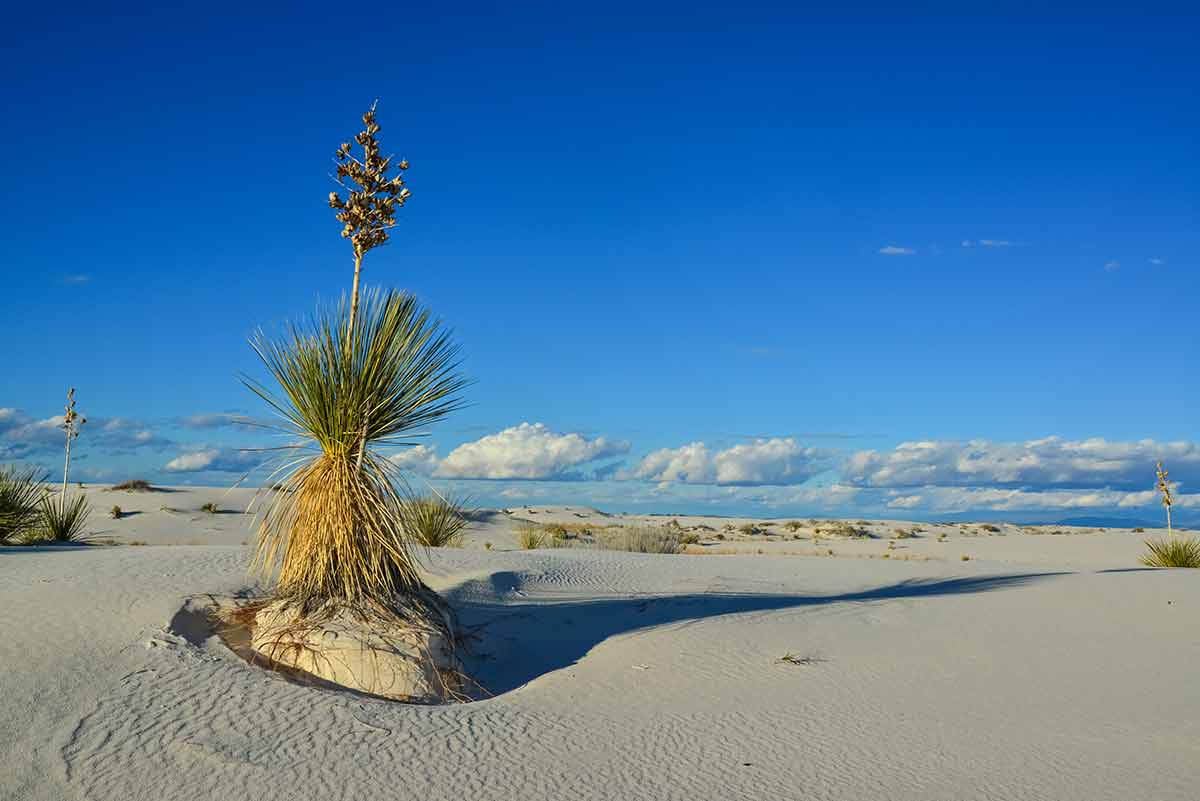
The Trinity monument marks the site of Operation Trinity, the code name used for the first detonation of a nuclear weapon test.
The test was carried out at the site at 5.29 am on 16 July 1945 and formed part of the Manhattan Project.
The bomb was detonated on 16 July 1945 on top of a 100-foot steel tower, creating a massive cloud that surged into the air and leaving a crater one-half mile across and eight feet deep.
The intense heat fused sand in the crater into a glass-like solid substance, the colour of green jade, called trinitite, and the explosion point is known as the Trinity Site.
The site is marked by a 12ft (3.7m) obelisk made from lava rock that sits at the hypocentre of the explosion. The US Army erected the monument n 1965.
Trinity Site is a National Historic Landmark at Jornada del Muerto, New Mexico 87102.
For more amazing European Landmarks, read:
- 30 Spain Landmarks
- 20 Switzerland Landmarks
- 22 Germany Landmarks
- 35 London Landmarks
- 30 France Landmarks
- 20 Italy Landmarks
- 20 Greece Landmarks
- 20 Russia Landmarks
- 20 Scotland Landmarks
- 20 Ireland Landmarks
- 21 Wales Landmarks
- 20 Turkey Landmarks
- 20 England Landmarks
- 20 Hungary Landmarks
- 21 Romania Landmarks
- 20 Ukraine Landmarks
- 20 Athens Landmarks
- 20 Rome Landmarks
- 20 England Landmarks
- 20 Portugal Landmarks
- 20 Poland Landmarks
- 20 Iceland Landmarks
- 20 Bulgaria Landmarks
- 21 Croatia Landmarks
- 20 Bulgaria Landmarks
- 20 Austria Landmarks
- 21 Finland Landmarks
- 20 Sweden Landmarks
- 20 Denmark Landmarks
- 20 Belgium Landmarks
- 20 Netherlands Landmarks
- 20 Barcelona Landmarks
- 21 Czech Republic Landmarks
- 20 Landmarks in Paris
- 20 Landmarks in Liverpool
- 10 Istanbul Landmarks
16- El Santuario de Chimayo
El Santuario de Chimayo is a beautiful historical landmark in New Mexico and the Roman Catholic Church is also a National Historic Landmark.
The church is relatively small, at 60ft (18m) in length and 24ft (7.3m) wide, and is an symmetrical structure built from adobe with a bell tower on each side.
The first chapel at the site was built in the early 1800s and expanded over the years.
Pedro Domingues, a 19th-century carpenter, carved the entrance doors that still remain today.
El Santuario de Chimayo is at 15 Santuario Dr, Chimayo, NM 87522.
17- Cumbres & Toltec Scenic Railroad
Constructed as part of the Rio Grande narrow gauge railroad, Cumbres & Toltec was built in 1880.
The extension to the San Juan railroad allowed a connection between the silver mines in San Juan to the rest of the state.
The railroad’s infrastructure was upgraded in the 1920s, allowing the railroad to flourish until it was abandoned in 1969.
Thanks to preservationists, in 1970, Colorado and New Mexico purchased the railroad and began to haul tourists along the line.
Today tourists can travel up the railroad and enjoy the scenic views on a restored steam train and dine in style.
Cumbres & Toltec Scenic Railroad is at 500 Terrace Avenue, Chama, NM 87520.
18- San Jose de Gracia Church
Built by Spanish Colonists between 1760 and 1776, San Jose de Gracia Church is a must-visit landmark in New Mexico.
The church is one of the best-preserved examples of Spanish Colonial churches in New Mexico and it’s not surprising it became a designated National Historic Landmark in 1970.
San Jose de Gracia follows the shape of a crucifix and is one of the least-altered churches of the period.
Like many older buildings and structures in the state, the church is built from adobe.
San Jose de Gracia Church is at 2377-2381 NM-76, Chamisal, NM 87521.
19- Acoma Pueblo
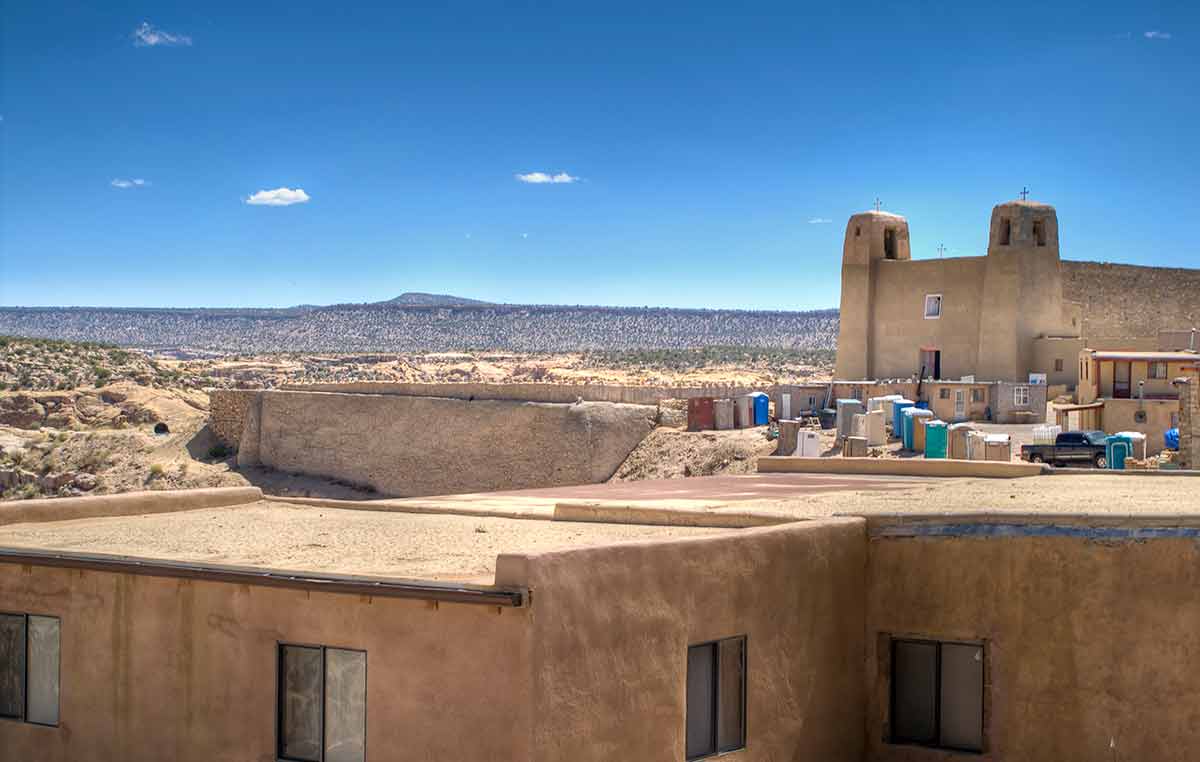
Acoma Pueblo is a village built on the 357-foot (110 m) high flat mountain rock and an incredible example of Native American architecture in New Mexico.
Acoma Pueblo is the traditional home of four communities – Sky City, Acomita, Anzac, McCartys and the San Estévan del Rey Mission church completed in 1640
The Acoma have lived in the area for more than 2000 years and have continuously occupied the pueblo.
Today about 30 people live in the pueblo as most residents moved to villages nearby, but the population swells as tourists and family visitors head to the area to explore, learn and see loved ones.
Start your visit at the Sky City Cultural Center and Haak’u Museum, where you can join a guided tour of the pueblo.
Acoma Pueblo is at Pueblo of Acoma, I-40, Exit 102, Acoma.
20- Gila Cliff Dwellings
Gila Cliff Dwellings is a 533-acre national monument consisting of dwellings linked to the Mogollon people.
The site is a ruin but features a range of buildings and other remains of the Mimbres Culture.
Archaeologists believe the Mogollon people lived in the region from the late 1200s to the early 1300s.
Within the cave dwellings, 46 rooms have been identified by archeologists who believe up to 15 families would have lived there.
Gila Cliff Dwellings is at Silver City, NM 88061.
21- The Blue Swallow Motel
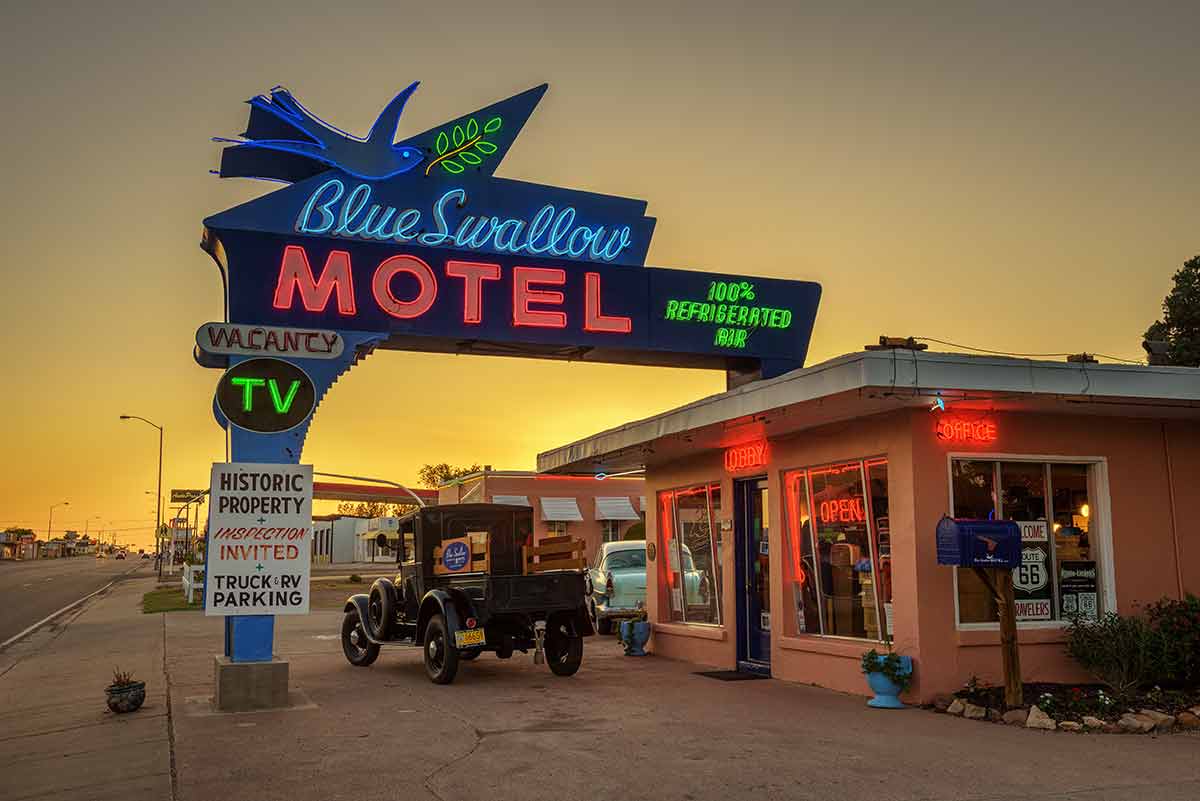
Along historic Route 66, the Blue Swallow Motel in Tucumcari is a historic landmark in New Mexico to pay a visit.
It’s one of the oldest motels that has continued to operate (it opened in 1942) and has original architectural features, such as pink stucco walls and neon signs.
The Blue Swallow Motel is at 815 East Route 66 Blvd. in Tucumcari.
Plan Your Trip

Rent A Car – Find the best car rental rates at Discover Cars. They compare car hire companies to provide you with the best deal right now.

Find A Hotel – If you’re curious about this article and are looking for somewhere to stay, take a look at these amazing hotels.





